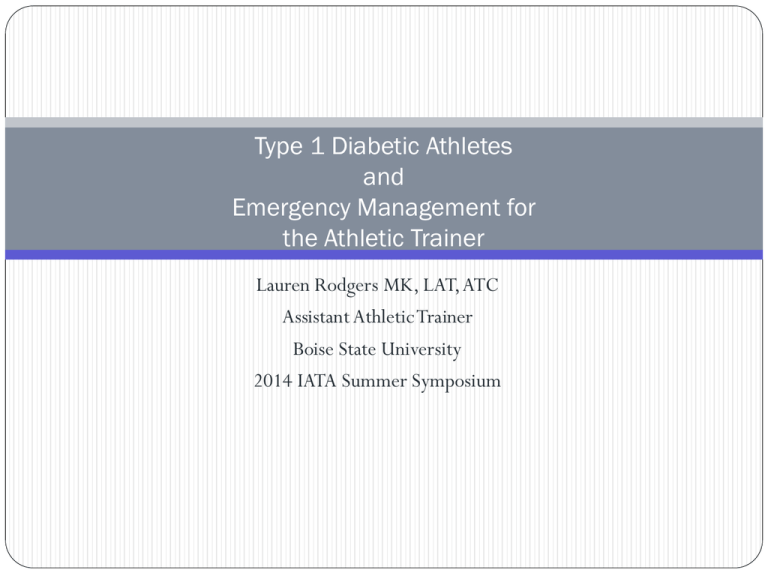
Type 1 Diabetic Athletes
and
Emergency Management for
the Athletic Trainer
Lauren Rodgers MK, LAT, ATC
Assistant Athletic Trainer
Boise State University
2014 IATA Summer Symposium
What is Diabetes?
Diabetes mellitus refers to a group of diseases that affect how
your body uses blood glucose, commonly called blood sugar.
Glucose is vital to your health because it's an important
source of energy for the cells that make up your muscles and
tissues. It's also your brain's main source of fuel. If you have
diabetes, no matter what type, it means you have too much
glucose in your blood, although the reasons may differ.
(Mayo Clinic, 2013)
Diabetes Mellitus
Type 1 (IDDM) is a genetic mutation that
triggers an auto-immune response
Environmental trigger causes the immune
system to destroy the beta cells in the pancreas
that produce insulin
Type 2 (NIDDM) is an insulin-resistance
because the body isn’t able to utilize the insulin
being produced
Accounts for 90-95% of 29.1 million people
with diabetes
Type 2 diabetics can become insulin dependent
if not controlled
Gestational Diabetes
Increased insulin resistance caused by hormones
being released in the placenta
Diabetes Statistics
American Diabetes Association, 2014
Prevalence: In 2012, 29.1 million Americans, or 9.3% of the population, had diabetes.
In 2010 the figures were 25.8 million and 8.3%. The prevalence rate for adults age 20
and older in 2012 was 12.3%, compared to 11.3% in 2010.
New Cases: The incidence of diabetes in 2012 was 1.7 million new diagnoses/year; in
2010 it was 1.9 million.
Deaths: Diabetes remains the 7th leading cause of death in the United States in 2010,
with 69,071 death certificates listing it as the underlying cause of death, and a total of
234,051 death certificates listing diabetes as an underlying or contributing cause of
death.
Cost of Diabetes (Updated March 6, 2013)
$245 billion: Total costs of diagnosed diabetes in the United States in 2012
$176 billion for direct medical costs
$69 billion in reduced productivity
After adjusting for population age and sex differences, average medical expenditures
among people with diagnosed diabetes were 2.3 times higher than what expenditures
would be in the absence of diabetes.
Blood Glucose
Blood Glucose (BG) is the
accumulation of glucose in
the blood stream
Measured in mg/dL
Blood sugar ranges:
Normal 80-150
Pre-meal 70-120
Post-meal < 200
Hemaglobin A1C: predicts
average blood sugars over
past 3 months
Diabetes Management
Glucometer
Continuous Glucose
Monitor (CGM)
Multiple Daily Injections
(MDI)
Multiple daily injections of
short-acting insulin for any
carb-intake
Once daily injection of
long-acting insulin for
sustained blood sugar
control
Pump Therapy
Continuous infusion of
short-acting insulin into
adipose tissue
Traditional Pump
Tubeless Pump
Effects of Exercise on BG
Insulin sensitivity is increased, so your
cells are better able to use any available
insulin to take up glucose during and
after activity (Zinman et al, 2004)
When your muscles contract during
activity, it stimulates another
mechanism that is completely separate
of insulin. This mechanism allows your
cells to take up glucose and use it for
energy whether insulin is available or
not (ADA, 2014)
Exercise Type
Intermittent High-Intensity Exercise
vs. Moderate Exercise (Guelfi et al,
2007)
Increase in BG vs Decrease in BG
Increased Insulin sensitivity up to 31
hours later (MacDonald, 1987)
(Gallen, 2004)
Unique Physiological Concerns for
Type 1 Diabetics
Glucose production and glucose
utilization balance (Guelfi et al, 2007)
Reducing pre-exercise insulin
25% pre-exercise, 50% post-exercise
(Campbell, 2013)
Reducing Short-Acting Insulin
45-min exercise session at 50% Vo2max
90 min after a standard meal, a 30–
50% reduction in the premeal insulin
(regular) dose was necessary to avoid
per-exercise hypoglycemia (RabasaLhoret et al, 2001)
(Gallen, 2004)
Reducing basal insulin (pump only)
Complete suspension decreased
hypoglycemic incidence by 27%
(DirecNet Study Group, 2006)
Meal Selection
Heat and cold effects insulin absorption
Trial and Error
Two Types of Diabetic Emergencies
HypoGlycemia
HyperGlycemia
Low blood sugar as a result
High blood sugar as a result
of too much insulin or not
enough food
BG < 70
Can result in LOC if BG
gets < 50
of not enough insulin or
too much food
BG > 200
Above 600 will likely go
into a diabetic coma
Signs and Symptoms
HypoGlycemia
Mild hypoglycemia
HyperGlycemia
Nausea
Extreme hunger
Feeling nervous or jittery
Cold, clammy, wet skin and/or excessive sweating not
caused by exercise
A rapid heartbeat
Numbness or tingling of the fingertips or lips
Trembling
Moderate hypoglycemia
Mood changes, such as irritability, anxiety, restlessness, or
anger
Confusion, difficulty in thinking, or inability to concentrate
Blurred vision, dizziness, or headache
Weakness, lack of energy
Poor coordination
Difficulty walking or talking, such as staggering or slurred
speech
Fatigue, lethargy, or drowsiness
Severe hypoglycemia
Seizures or convulsions
Loss of consciousness, coma
Low body temperature
Early signs of hyperglycemia include:
Increased thirst
Headaches
Difficulty concentrating
Blurred vision
Frequent urination
Fatigue (weak, tired feeling)
Weight loss
Blood sugar more than 180 mg/dL
Prolonged hyperglycemia in diabetes
may result in:
Frequent infections
Slow-healing cuts and sores
Decreased vision
Nerve damage causing painful, cold, or
insensitive feet, loss of hair on the lower
extremities
Stomach and intestinal problems
(ADA, 2014)
Managing Diabetic Emergencies
Assess the signs and symptoms, and if they are coherent ask
the athlete how they feel and what they have done in the past
hour to manage their diabetes
Blood Sugar Testing
Meter, Strips, Lancet
Knowing the numbers
Hypoglycemia Treatment
If blood sugar is below 70, administer 15-20 g of sugar, wait
15 minutes, then test the blood sugar again
Best forms of sugar:
½ cup of regular soda or juice
4-6 pieces of hard candy
Glucose tablets or gel
1 TBSP of honey or table sugar
Foods high in fat or fiber take longer to digest and raise the
blood sugar, so avoid chocolate or bread to treat low blood
sugar
Glucagon Pen for Hypoglycemia Emergencies
Hyperglycemia Treatment
Different types of insulin do different things
Short-acting (meals)
Long-acting (daily)
Typical correction scale is 1:50
For every 50 points the individual is above their range,
take one unit of short-acting insulin
Different for everyone so check
Encourage the athlete to drink plenty of water
If BG is above 250, check for ketones when possible
If unable to help themselves with the shot, you must
call 911 or transport to the hospital
If BG is above 600, transport to the hospital
Likely in DKA
Diabetic Ketoacidosis (DKA)
Inability to use the sugar in the blood stream causes the
body to utilize fat and muscle breakdown to fuel the body,
creating ketones (fatty acids) to build up, creating pH
imbalances (Mayo Clinic, 2013)
Symptoms include:
Flushed, hot, dry skin
Blurred vision
Feeling thirsty
Drowsiness or difficulty waking up
Rapid, deep breathing
A strong, fruity breath odor
Loss of appetite, belly pain, and vomiting
Confusion
Brain swelling, and eventually coma or even death
Supplies for the Athletic Trainer
NATA Position Statement: Management of the Athlete with
Type 1 Diabetes Mellitus (2007)
Provided by the athlete:
Diabetes Care Plan
Blood glucose monitoring equipment and supplies: testing
strips, lancets, insulin (check exp. date frequently)
Supplies to treat hypoglycemia: glucose tablets, sugar packets,
orange juice, regular soda, Glucagon Pen
Ketone Testing supplies: Urine or blood
Sharps container
Spare batteries
Take Home Message…
Get to know your athletes
Insulin Types, Pump vs. Injections
Signs and Symptoms
Personality
Know the Numbers
Hypoglycemia vs. Hyperglycemia
Have a Plan
Famous Athletes with Diabetes
Walt Arnold (former football player, K.C. Chiefs)
Walter Barnes (former football player, Phila. Eagles)
Doug Burns (Mr California ’97, subsequent Mr. Universe)
Bill Carlson (Ironman triathlete)
Bobby Clark (former hockey player, Phila Flyers)
Ty Cobb (former baseball player)
Mallory Code (women’s Pro Golfer)
Tony Conigliaro (former baseball player, Boston Red Sox)
Jay Cutler (quarterback, Denver Broncos)
James “Buster” Douglas (professional boxer)
Kenny Duckett (football player, Dallas Cowboys)
Mike Echols (Cornererback, Tennessee Titans)
Darren Eliot (former hockey player, L.A. Kings)
Pamela Fernandes (Olympic Gold Medal cyclist)
Missy Foy (Olympic Ultra Marathoner)
Curt Fraser (former hockey player, Minnesota Northstars)
Smokin’ Joe Frazier (former boxer)
Kris Freeman (Olympic Skier, silver medalist)
Rich Gedman (baseball player, Boston Red Sox)
Bill Gullickson (former pitcher, Houston Astros)
Gary Hall, Jr. (Olympic swimmer/gold medalist)
Tom Hallion (Major League Umpire)
Jonathan Hayes (former football player, K.C. Chiefs)
Vance Heffner (pro golfer)
Chuck Heidenrich (professional skier)
Catfish Hunter (Hall of Fame baseball player)
Jason Johnson (pitcher, Baltimore Orioles)
Zippora Karz (ballerina, New York City Ballet)
Billy Jean King (tennis legend)
Ted Kluszewski (former baseball player, Cincinnati Reds)
Ed Kranepool (former baseball player, NY Mets)
Kelli Kuehue (LPGA two-time champion, pumper)
Jay Leeuwenburg (Guard/Center in NFL)
Mark Lyle (professional golfer)
Gary Mabult (UK soccer champion)
Adian Marples (Ironman triathlete)
Michele McGann (LPGA)
Corbin Mills (bike racer)
Minni Minosa (former baseball player, Chicago White Sox)
Adam Morrison (pro basketball player, LA Lakers)
Calvin Muhammed (former football player, Washington Redskins)
Fred Patek (former baseball player, K.C. Royals)
Mike Pyle (former football player, Chicago Bears)
Steve Redgrave (Olympic rowing gold medalist)
Dan Reichert (pitcher, Kansas City Royals)
Ham Richardson (tennis player)
Jackie Robinson (former baseball star)
Sugar Ray Robinson (former boxer)
Ron Santo (former baseball star, Chicago Cubs)
Art Shell (former football player, Oakland Raiders)
Mike Sinclair (former NFL defensive end)
Bill Talbert (tennis star)
Michael Treacey (sky jumper)
Sherri Turner (pro golfer)
Jerry Udjur (former baseball player, Detroit Tigers)
Scott Verplank (pro golfer)
Jersey Joe Walcott (boxing)
Joanne Washam (pro golfer)
Wade Wilson (former NFL quarterback)
References
American Diabetes Association. (2014). Exercise and Type 1 Diabetes. Retrieved July 7, 2014, from
http://www.diabetes.org/food-and-fitness/fitness/exercise-and-type-1-diabetes.html?loc=ff-slabnav
Guelfi, K.J., Ratnam, N., Smythe, G.A., Jones, T.W., and Fournier, P.A. (2007). Effect of intermittent high
intensity compared with continuous moderate exercise on glucos production and utilization in
individuals with type 1 diabetes. American Journal of Physiology – Endocriniology and Metabolism Vol.
292. doi:10.1152/ajpendo.00533.2006
Zinman, B., Ruderman, N., Campaigne, B., Devlin, J. Schneider, S. (2004). Physical Activity/Exercise and
Diabetes. Diabetes Care SuppVol 87:1. 58-62.
Gallen, I.W. (2004). Review:Helping the Athlete with Type 1 Diabetes. British Jounrnal of Diabetes &
Vascular Disease. Vol 4:87. doi: 10.1177/14746514040040020401
MacDonald, M.J. (1987). Post-exercise late-onset hypoglycemia in insulin-dependent diabetic
patients. Diabetes Care Vol 10. 584-588. doi 10.2337
Campbell, M.D., Walker, M., Trenell, M.I., Jakoviljevic, D.G., Stevenson, E.J., Bracken, R.M, et. Al. (2013).
Pre- and Postexercise Rapid-Acting insulin reduction preserve glycemia and prevent early- but
not late-onset hypoglycemia in patients with Type 1 diabetes. Diabetes Care Vol. 36:8. 2217-2224.
Rabasa-Lhoret, R., Bourque, J., Ducros, F., Chiasson, JL. (2001). Guidelines for premeal insulin dose
reduction for postprandial exercise of different intensities and durations in Type 1 diabetic
subjects treated intensively with a basal-bolus insulin reimen. Diabetes Care Vol 24:4. 624-630. doi:
10.2337
The Diabetes Research in Children Network (DirecNet) Study Group. (2006). Prevention of hypoglycemia
during exercise in children with Type 1 diabetes by suspending basal insulin. Diabetes Care Vol
29:10. 2200-2204.
Jimenez, C., Corcoran, M., Crawley, J., Hornsby, W., Peer, K., Philivin, R., Riddell, M. (2007). National
Athletic Trainers’ Association Position Statement: Management of the Athlete with Type 1
Diabetes Mellitus. Journal of Athletic Training. 42 (4). 536-545.
Questions?









